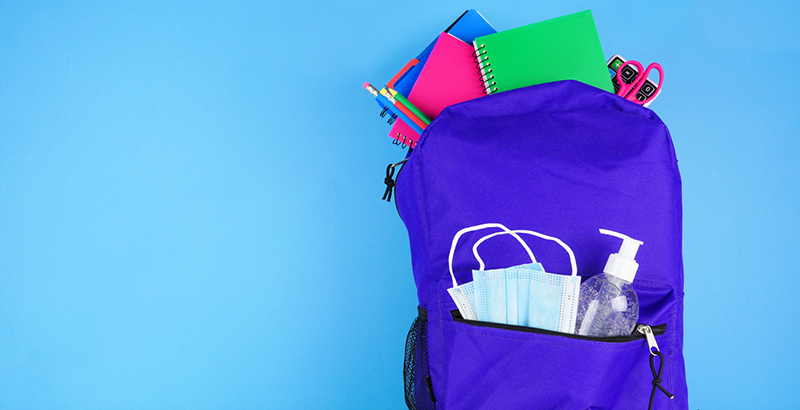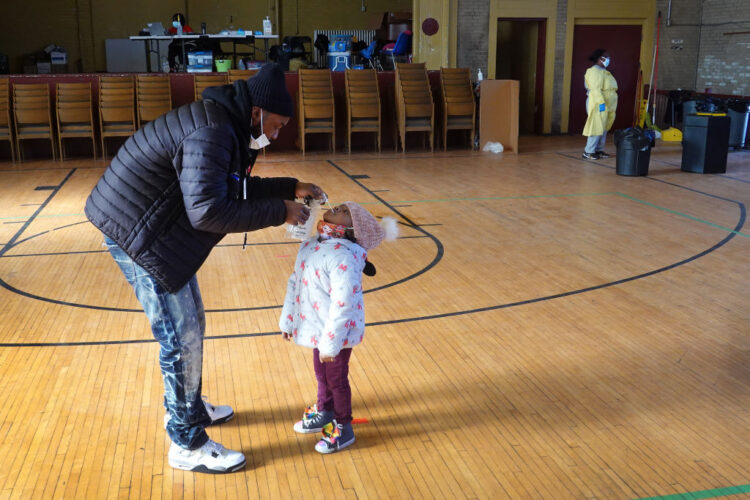Many Kids Who Had COVID Don’t Have Antibodies to Protect Against Omicron
A weekly roundup of headlines about how the pandemic is shaping schools and education policy, vetted by AEI Visiting Fellow John Bailey

This is our weekly briefing on how the pandemic is shaping schools and education policy, vetted, as always, by AEI Visiting Fellow John Bailey. Click here to see the full archive. Get this weekly roundup, as well as rolling daily updates, delivered straight to your inbox — sign up for The 74 Newsletter.
This Week’s Top Story

Many Children Who Contracted COVID-19 Did Not Develop Antibodies to Ward Off Omicron: Study / Statement
- A new study from researchers at Harvard Medical School, Boston Children’s Hospital and the FDA shows that fewer than 10% of kids who contracted COVID-19 in 2020 or early 2021 developed antibodies capable of warding off the Omicron variant of the virus.
- “ ‘I hear parents say, “Oh, my kid had COVID last year,” ’ said Dr. Adrienne G. Randolph, a co-senior investigator on the HMS/Children’s study and HMS professor of anesthesia and of pediatrics at Boston Children’s, in the statement. ‘But we found that antibodies children produced during prior infections don’t neutralize Omicron. This means that unvaccinated children are still susceptible to Omicron.’ ”
- “Overall, children and adolescents show some loss of cross-neutralization against all variants, with the most pronounced loss against Omicron. In contrast to SARS-CoV-2 infection, children vaccinated twice demonstrated higher titers against Alpha, Beta, Gamma, Delta and Omicron. These findings can influence transmission, re-infection and the clinical disease outcome from emerging SARS-CoV-2 variants and supports the need for vaccination in children.”
The Big Three — June 10, 2022
As Students Struggled to Learn, Teachers Reported Few Strategies Helped Mitigate Learning Loss: Government Accountability Office report
- “52% had more of their students start the 2020-21 school year behind compared to a typical school year, and that this affected younger students more than older students.”
- “64% had more students make less academic progress than in a typical school year.”
- “45% of teachers had at least half of their students end the year behind grade level.”
How Teens Navigate School During COVID-19: Via Pew Research
- In-person preference: 65% of teens say they would prefer school to be completely in person after the COVID-19 outbreak is over, 9% would opt for a completely online environment, 18% say they prefer a mix of both online and in-person instruction.
- Virtual learning: 28% of teens say they are extremely or very satisfied with the way their school has handled virtual learning, while a similar share report being only a little or not at all satisfied with their school’s performance.
- Parent perspective: 44% of parents living in households earning less than $30,000 a year say they are extremely or very worried their teen has fallen behind in school because of COVID-19 disruptions, but this falls to 24% among those whose annual household income is $75,000 or more.
- Digital divide: About 1 in 5 teens (22%) say they often or sometimes have to do their homework on a cellphone; 12% say they at least sometimes are not able to complete homework assignments because they do not have reliable access to a computer or internet connection.
- Read more from The 74.
K-12 Budgets Should Be in Great Shape. But Inflation Is Taking a Toll: Via EdWeek
- “The overall economy has been strong, but is there reason to worry about what happens if the economy heads south again?”
- Learning Policy Institute’s Michael Griffith: “State funding comes primarily from sales and income taxes. State funding accounts for about 50% of the money that comes in to public education, and sales and income taxes can fluctuate greatly. Anytime there’s a downturn in the economy, there’s a concern there.”
Federal Updates
Treasury: Announced that Louisiana, New Hampshire, Virginia and West Virginia were the first states to be approved to receive funds from Treasury’s Capital Projects Fund. The money will be used to connect more than 200,000 homes and businesses to affordable high-speed internet
City & State News
California
Mask mandates are being reinstated at some school districts amid a rising tide of COVID-19
Florida
Florida’s Alarming Reading Scores: Third-Grade Test Shows Only 1 in 4 Proficient
Louisiana
Schools that require COVID vaccine could soon face lawsuits
Michigan
Detroit district’s virtual school tightens rules to tackle absenteeism
Oklahoma
Bets on school counseling corps to address ‘Mental Health Deserts’
Virginia
Parents in Fairfax question county’s plan to address learning loss.
COVID-19 Research
FDA Committee Meets on Novavax
- The Vaccines and Related Biological Products Advisory Committee met this week to review Novavax’s submission for an emergency use authorization for its COVID vaccine. Stat’s Helen Branswel live-tweeted the meeting.
- FDA advisory committee vote on whether benefits of Novavax vaccine as primary series outweigh risks for adults: Yes: 21 No: 0 Abstain: 1
- FDA doesn’t have to follow the committee’s advice, but it generally does.
- Axios: “If the FDA follows the recommendation, the vaccine would become the fourth COVID shot authorized for use in the U.S.”
- “Its vaccine uses a protein from the target virus combined with what’s called an adjuvant to enhance the body’s immune response. It’s easier to store than Moderna and Pfizer’s vaccines.”
- “Regulators on Tuesday said Novavax could fill an unmet need because there aren’t non-mRNA COVID vaccines that can serve as first-line defenses. That could persuade some unvaccinated people to get the shots.”
- New York Times: “But before the agency could authorize the shots, the FDA would need to sign off on Novavax’s manufacturing process, which has stumbled again and again over the course of two years. Those ongoing issues are likely to mean the vaccine will not be available for weeks, in contrast to the already cleared COVID vaccines that became available just days after the same committee endorsed those shots.”
How Many Are Not Up to Date with Vaccination in Counties with Elevated COVID-19 Community Levels?: Via Kaiser Family Foundation
- “There are 120 million people living in counties with elevated COVID-19 community levels who are not up to date on their COVID-19 vaccines. These include those who are unvaccinated, partially vaccinated and those who are vaccinated but not yet boosted, putting them at higher risk of severe illness and death. Together, they represent about half of all those in the U.S. who are not up to date on vaccines.”
The Association Between COVID-19 Mortality and the County-Level Partisan Divide in the U.S.: Study / article in Stat / more via CIDRAP
- “In this observational study that captured data from a majority of U.S. counties, we compared the number of COVID-19 deaths through Oct. 31, 2021, among counties with differing levels of Republican vote share, using 2020 presidential election returns to characterize county political affiliation.”
- “We found a positive dose-response relationship between county-level Republican vote share and county-level COVID-19 mortality. Majority Republican counties experienced 72.9 additional deaths per 100,000 people relative to majority Democratic counties during the study period, and COVID-19 vaccine uptake explains approximately 10 percent of the difference.”
More Notable Research
- Ventilation Improvement Strategies Among K-12 Public School: CDC report shows “differences in schools’ reported ventilation improvement strategies by school characteristics, including [National Center for Education Statistics] locale and school poverty-level status.”
- BA.4 and BA.5: Potentially the most transmissible Omicron subvariants yet
- COVID Booster in NBA Cut Infection Risk 57% amid Omicron: JAMA study
- Moderna’s COVID-19 Vaccine Targeting Omicron Produces Stronger Immune Response: Press release
Viewpoints
Districts Have Rushed to Buy Tutoring Programs: EdWeek asks, “Is Their Evidence Base Keeping Up?“
- “For companies, building a strong evidence base will be increasingly important to their success in a competitive market. And experts say establishing a research base could also lay the foundation for tutoring to remain a more integral part of the K-12 system, long term.”
- “As a new company, launched in 2021, Tutored by Teachers hasn’t done a trial or study, and isn’t necessarily rushing to do so. The provider — which offers one-on-one and small group online intervention and uses credentialed teachers exclusively — targets struggling learners and mostly serves students of color or students living in poverty, two groups that typically don’t score as well on standardized tests.”
- “There’s a balancing act for school districts between prioritizing a product or service being evidence-based and making a solution that is affordable and reaches as many students as needed.”
A Wake-Up Call for Public Education: Via Michael Bloomberg:
- “Nearly 1.3 million students have left public schools since the pandemic began. Most states have seen enrollment declines for two straight years. In New York City, K-12 enrollment has dropped by an astounding 9%.”
- “Given that state education funding formulas rely on student population numbers, a large reduction in students will lead to a corresponding reduction in school budgets.”
- “The message to educators and elected officials could hardly be clearer: Too many public schools are failing, parents are voting with their feet, and urgent and bold action is needed.”
- “Now, after students have fled public schools in record numbers, states are paying more to educate fewer children. That might have been acceptable if students were showing great improvement. Instead, we are paying more for failure.”
- “The new enrollment data sends a stark signal. Schools will have to adjust to dropping enrollments either by getting smaller or by getting better. You can’t lose the students and keep the teachers.”
…And on a Lighter Note
Dance Like Nobody’s Watching: Or just get excited that it’s the weekend.
ICYMI @The74
Weekend Reads: In case you missed them, our top stories of the week:
- Student Activism: After Uvalde Shooting, Parkland Survivors Head Up Huge Gun Safety Rally — Again
- Microschools: Great Hearts Hopes In-Person Pods + Online Teaching = New Type of Hybrid School
- Texas: Gov. Abbott Wanting to Bar Undocumented Kids From School Echoes Failed Past Policies
For even more COVID policy and education news, subscribe to John Bailey’s daily briefing via Substack.
Disclosure: John Bailey is an adviser to the Walton Family Foundation, which provides financial support to The 74.
Get stories like these delivered straight to your inbox. Sign up for The 74 Newsletter

;)
